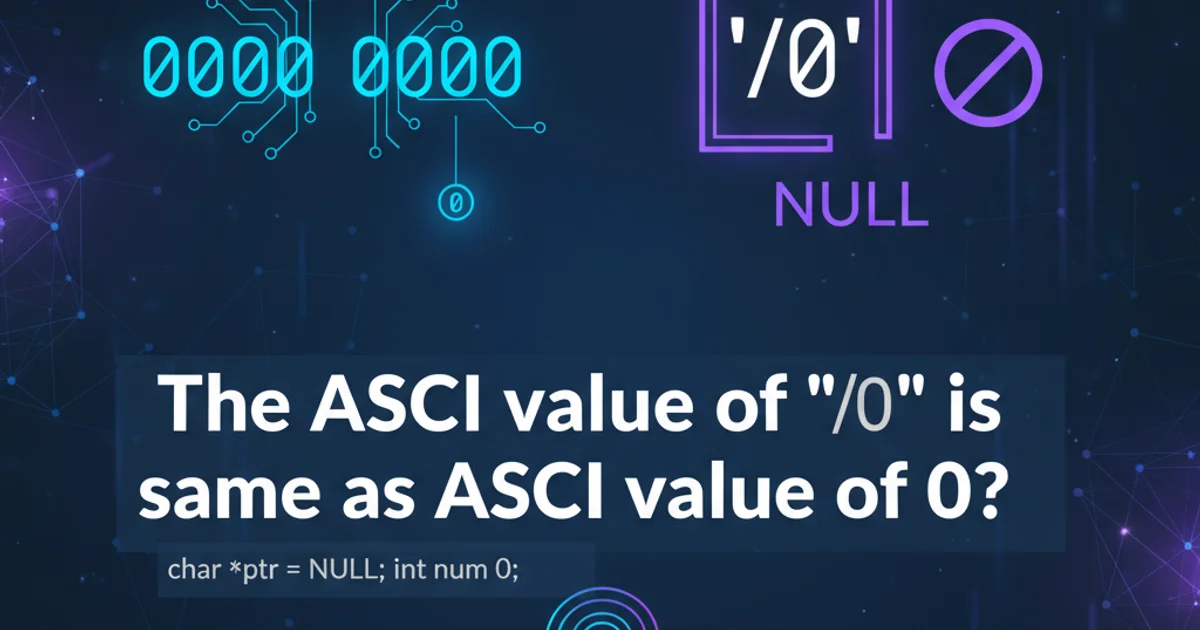The ASCII value of '\0' is same as ASCII value of 0?
Categories:
Understanding Null Terminators: Is '\0' the Same as 0 in ASCII?

Explore the nuances of the null character ('\0') and the integer 0 in the context of ASCII and C programming, clarifying their distinct roles and representations.
In C programming, and many other contexts, the null character \0 and the integer 0 often appear interchangeable, leading to confusion. While they share the same underlying numerical value in ASCII and related encodings, their purpose and interpretation are fundamentally different. This article will clarify these distinctions, especially in the context of character arrays and string termination.
The ASCII Value of '\0' and 0
The American Standard Code for Information Interchange (ASCII) assigns numerical values to characters. For the null character, represented as \0 in C, its ASCII value is indeed 0. This is a non-printable control character, historically used for padding or as a string terminator. The integer literal 0 also represents the numerical value zero. This shared numerical representation is the root of the common misconception.
flowchart TD
A["Character '\0'"] --> B{"ASCII Value"}
B --> C["0 (Decimal)"]
D["Integer 0"] --> BRelationship between '\0' and 0 in ASCII
Context is Key: Character vs. Integer
While both \0 and 0 evaluate to the same numerical value, their types and typical usage differ significantly. \0 is a character literal of type char, specifically the null character. 0 is an integer literal of type int. In C, a char is an integer type, typically 1 byte, capable of holding a small integer value. This allows for implicit conversions, but it's crucial to understand the intent behind their use.
#include <stdio.h>
int main() {
char null_char = '\0';
int zero_int = 0;
printf("Value of null_char: %d\n", null_char); // Prints 0
printf("Value of zero_int: %d\n", zero_int); // Prints 0
if (null_char == zero_int) {
printf("null_char and zero_int are numerically equal.\n");
}
return 0;
}
Demonstrating the numerical equivalence of '\0' and 0
char in C is an integer type. This means you can perform arithmetic operations on characters, and they will behave like their corresponding ASCII (or other encoding) integer values.The Role of '\0' in C Strings
The most critical distinction lies in their application. In C, strings are character arrays terminated by a null character \0. This null terminator signals the end of the string to functions like printf, strlen, and strcpy. Without it, these functions would continue reading memory until they encounter a 0 byte by chance, or cause a segmentation fault.
#include <stdio.h>
#include <string.h>
int main() {
char str1[] = "Hello"; // Automatically null-terminated
char str2[] = {'W', 'o', 'r', 'l', 'd', '\0'}; // Explicitly null-terminated
char str3[] = {'N', 'o', 'n', 'e'}; // NOT null-terminated
printf("str1: %s (length %zu)\n", str1, strlen(str1));
printf("str2: %s (length %zu)\n", str2, strlen(str2));
// printf("str3: %s (length %zu)\n", str3, strlen(str3)); // DANGER: Undefined behavior!
return 0;
}
The importance of '\0' as a string terminator